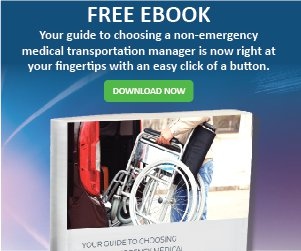
Patient flow is a major concern for hospitals and healthcare providers everywhere. When patient flow is obstructed, the ensuing long delays could deter patients from obtaining the medical consultation and treatment they need. Not only does poor patient flow have a negative impact on a health care provider's bottom line — patients who leave before they see a doctor represent lost revenue — but it can put beneficiaries' health at risk.
Improving patient flow should be a priority for hospitals, health care providers and managed care organizations (MCOs) alike. Gathering more data can help shed light on the problem and point stakeholders toward potential solutions. In particular, non-emergency medical transportation data can provide insight into discharge practices and where they fall short.
Patient flow obstructions increase health risks
Hospitals and medical facilities that operate efficiently can consistently discharge patients in a timely fashion and turn over available beds. Conversely, organizations that struggle with patient flow can easily find themselves inundated with people waiting to speak with a doctor or receive treatment.
Delays caused by poor patient flow can have a detrimental effect on the health of patients since individuals may decide to leave if they have to wait an inordinate amount of time to be seen. Furthermore, waiting rooms can fill up quickly when appointment scheduling and facility operations are not tightly coordinated. That, in turn, can overwhelm both administrative staff and caregivers, potentially leading to a lower quality of care and a worse patient experience. As these inefficiencies are compounded, the resulting bottlenecks and pain points grow more pronounced. Communication breakdowns between departments may arise, further exacerbating patient flow issues.
Without direct intervention, patient flow obstructions can generate their own vicious cycles where hospital staff are frequently overwhelmed and dissatisfied patients suffer through interminable delays.
Addressing patient flow at the point of discharge
One of the major concerns that health care providers need to address is how their discharge practices affect overall patient flow. A big piece to the puzzle is consistent and reliable NEMT solutions. It's not unusual for someone to be discharged from a medical facility without any means to get home. When that happens, they may be forced to stay longer hours, even overnight, taking up a hospital bed that should go to a patient waiting to be treated.
Even Medicare beneficiaries that have NEMT services available to them may run into problems if they can't schedule trips on an as-needed basis. It can be difficult to predict how long even a simple physical will take — especially if patient flow is already a significant issue. As such, NEMT users may schedule their return trip for the wrong time, or wait until their appointment is over to set up a ride home.
If your NEMT manager doesn't support 24/7 scheduling, beneficiaries could be left in the lurch, taking up a hospital bed or dialysis chair as they wait for their ride. Patients should be able to schedule a trip home whenever they need it and expect a driver to arrive without delay.
Of course, the patient flow cycle begins long before discharge, and NEMT can help prevent a logjam at the front end. Consider what happens if a patient shows up late to a dialysis session. They’re not going to be turned away from receiving such critical treatment, but facility administrators will have to make a choice between giving that patient a shorter treatment — and impacting their health in the process —- or pushing the next patient back to accommodate them.
These instances can have a domino effect, causing further delays and requiring technicians and nurses to stay well past their regular shifts to provide treatment. Staff working longer hours than expected can be a major drain on facility resources, especially those that run on very tight budgets.
More data means more insight
NEMT solutions should provide ample transportation data to analyze patient discharge trends and spot potential issues that could affect patient flow. For instance, if a particular transportation provider continually misses pickups or arrives late, NEMT data can bring that situation to light.
Moreover, having more visibility into non-emergency medical transportation can also help health care providers better align their operations with NEMT services. Knowing precisely when a patient is slated to arrive at the facility and be picked up after their appointment helps administrators with accurate and efficient scheduling.
Going a step further, real-time NEMT visibility enables health care providers to see if a patient is en route to the facility, will be late to their appointment or is likely to be a no-show. That takes more of the guesswork out of scheduling and allows staff members to plan accordingly.
Sophisticated NEMT solutions needed for today's challenges
NEMT technology is a huge boon for both MCOs and health care providers, as well as beneficiaries. The most advanced and sophisticated NEMT solutions provide an incredible amount of visibility for everyone involved, removing confusion, allowing health care processes to run efficiently and greatly improving the patient experience. LogistiCare and Circulation's revamped NEMT platform offers unparalleled monitoring capabilities, allowing for real-time visibility on a macro or micro level. Using GPS, stakeholders can see precisely where a driver is, providing ample time to plan around expected delays.
The LogistiCare NEMT platform also produces an incredible amount of data to inform health care decision-making, helping to create a better patient experience.
Are you interested in learning more about how LogistiCare l Circulation can help your organization improve patient flow? Request a demo



